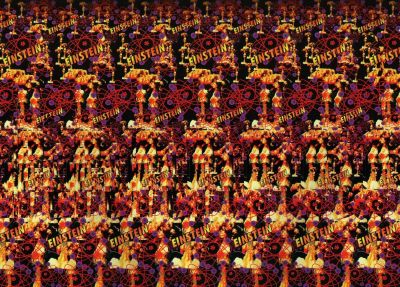

Our understanding of how populations of neurons modelled in this way give rise to the perception of depth has been greatly enhanced by the use of random dot stereograms (RDS). This forms the input to the second order filters (blue pathway) where the pairs of monocular filters are summed, squared and combined to calculate the second-order binocular energy response. The first-order responses are squared and summed, to produce monocular energy responses for each eye.

Outline of a second order binocular energy model (green and blue pathway): Odd and even monocular energy responses are calculated separately for each eye (green pathway). The squared outputs are summed across the two halves of the quadrature pair. Responses are summed across the two eyes for corresponding filters, then squared. Outline of a first order binocular energy model (orange pathway): Odd and even symmetric monocular receptive fields (white areas represent excitatory regions of the receptive fields and dark areas inhibitory regions) are combined to compute the first order binocular energy response. This broad distribution of binocular processing reflects the importance of three-dimensional information for both action and perception, and demonstrates the complexity of extracting depth from binocular signals. At higher levels of visual processing, binocular responses are found in both the dorsal and ventral streams. ĭisparity-tuned neurons in the primary visual cortex form the early stages of a broadly distributed network of binocular processing. Point 1 will appear closer and 3 further away. This uncrossed disparity arises as this point is further away than the fixation point. Conversely, there is a rightward shift of point 3 from the left to the right eye’s image. This crossed disparity arises as this point in the image is closer than the fixation point. For point 1, there is a small shift leftwards in the right eye’s image in comparison to point 1 in the left eye’s image. The point of fixation falls on the same retinal location and has zero disparity. And try again.Each eye, the left (top) and right (bottom), receives a different image depending on fixation (point 2). If you lose focus, stay where you are and lower the stereogram, focusing again on the object behind it. The image should snap into place and become recognizable.Ħ. Once you can see this, try holding the stereogram up while allowing your eyes to slowly adjust. There should be a sweet spot in which you can begin to see the blurry three-dimensional picture within the stereogram when you raise it to your eyes. Once you’re able to keep your focus on the object and not the stereogram, try repeating this at different distances away from the object.ĥ. This means that your eyes will remain focused on the object instead and won’t readjust on the stereogram.Ĥ. Continue to look at the object and not the stereogram, even when the stereogram is blocking it. Move the stereogram up from underneath the object until it’s blocking your view of the object.ģ. Pick up the stereogram and look at the object that you’ve selected. Choose an object in the room you’re in – a photograph on the wall or a potted plant on a table in the corner.Ģ. Still not seeing it? Try to train your eyes this way:ġ. Once the image snaps into place, you should be able to see a sharp three-dimensional picture. You should be able to see the beginnings of a blurry three-dimensional picture.Ĥ. When you’re confident that your eyes can continue to look through the stereogram, move the image back and forth until the patterns begin to overlap. It may take a couple of tries to get this to work.ģ. Continue to look through the image as you move it away from you. This is the point at which your eyes will try to do what they do naturally – readjust focus. Then move the stereogram slowly away from your eyes. Hold it horizontally and look through the image as if it weren't right in front of you.Ģ. Start by putting your face up close to the printed stereogram or the digital screen with which you’re viewing it. The good news is, once you have successfully trained yourself to look at a stereogram, it will be that much easier from then on.ġ.
5d stereogram how to#
Here are a few tips and tricks that can teach you how to do it properly.


 0 kommentar(er)
0 kommentar(er)
